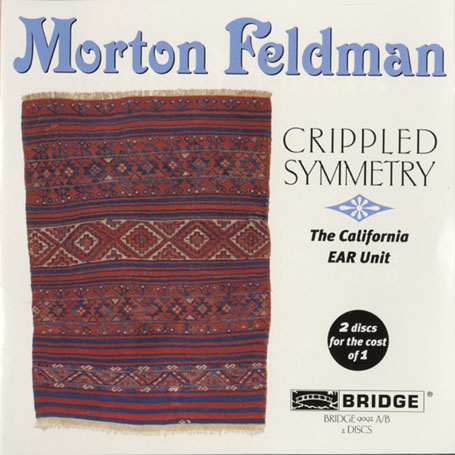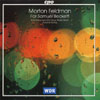Feldman Crippled Symmetry
The cause of 'crippled symmetry' is well served by two new Feldman releases
View record and artist detailsRecord and Artist Details
Composer or Director: Morton Feldman
Label: Bridge
Magazine Review Date: 4/2000
Media Format: CD or Download
Media Runtime: 87
Mastering:
DDD
Catalogue Number: BCD9092

Tracks:
| Composition | Artist Credit |
|---|---|
| Crippled Symmetry |
Morton Feldman, Composer
California EAR Unit Morton Feldman, Composer |
Composer or Director: Morton Feldman
Label: CPO
Magazine Review Date: 4/2000
Media Format: CD or Download
Media Runtime: 43
Mastering:
DDD
Catalogue Number: CPO999 647-2

Tracks:
| Composition | Artist Credit |
|---|---|
| For Samuel Beckett |
Morton Feldman, Composer
Berlin Neue Musik Morton Feldman, Composer Roland Kluttig, Conductor |
Author: Peter Dickinson
As later Feldman goes, Crippled Symmetry (1981) is not a long work at 87 minutes - the notorious String Quartet II from the same year lasts six hours! The opening is obsessed with a widely spaced four-note figure on the flute which, as so often in later Feldman, is using the notes within the B-A- C-H motif. This is backed by humming vibraphone and slender middle-register piano. Even this narrowly defined opening is eventful in Feldman's terms. At 1'08'' the percussionist switches to glockenspiel; at 1'22'' the pianist moves to celesta; and alternations continue. The flute reduces to a two-note figure at 3'13''; the piano introduces lower notes at 3'40''; and then the flute changes to bass flute. And so on with kaleidoscopic shifts throughout. By track 3 (not a formal division) on the first CD there are rising scales in the flute; but track 2 of the second CD finds the dedicated flute player reiterating a low A from 6'03'' for more than three minutes, luring the other players into single repeated notes as everything evaporates in Feldman's elegant romantic wasteland.
The Irish/American Beckett/Feldman relationship, comparable to Joyce/Cage, gave rise to Words and Music and the opera Neither (10/98). For Samuel Beckett is scored for double woodwind, muted brass septet, harp, piano, vibraphone and string quintet and dates from 1987, the last year of Feldman's life. The piece has the magnificent statuesque grandeur of Varese, well realised by the Berliners, and shows Feldman, in Satie's phrase, as intransigent to the end. Both these admirable releases are well recorded and add substantially to the rapidly growing profile of Feldman on CD.'
Discover the world's largest classical music catalogue with Presto Music.

Gramophone Digital Club
- Digital Edition
- Digital Archive
- Reviews Database
- Full website access
From £8.75 / month
Subscribe
Gramophone Full Club
- Print Edition
- Digital Edition
- Digital Archive
- Reviews Database
- Full website access
From £11.00 / month
Subscribe
If you are a library, university or other organisation that would be interested in an institutional subscription to Gramophone please click here for further information.




